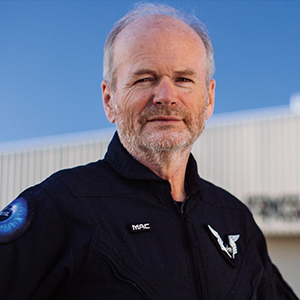
From University Avenue to the Universe
It’s 50 years since the first humans landed on the Moon. Today, Glasgow’s scientific and engineering expertise is helping to shape the space industry of the future.
When Neil Armstrong set foot on the Moon on 20 July 1969, space was the exclusive preserve of rival superpowers with seemingly unlimited resources competing for global prestige. Since then, a market-driven democratisation of space has opened up the sector to a mixture of multinational agencies, state programmes and private industry, creating exciting new opportunities for research and development.
The UK space industry alone is estimated to be worth more than £12 billion and the University of Glasgow has established itself as a leading national, international and interplanetary player.
“Our goals at Glasgow.” says Colin McInnes, James Watt Chair, Professor of Engineering Science, “are to enhance our understanding of space and devise, develop and demonstrate a range of next-generation space technologies which will help shape the space industry of the future.”
“Glasgow’s approach is a mix of applied research and very long-term thinking on space technology, as well as working with Glasgow-based space companies on research with a direct commercial impact.”
From micro to macro
From swarms of wafer-sized satellites generating more accurate space weather data to vast gossamer structures reflecting solar power for use on Earth during hours of darkness, Glasgow is at the very forefront of emerging micro to macro space technologies.
On the micro-scale, researchers are developing 3cm2 sensors which could be placed in orbit in large numbers, described as clouds or swarms, to provide an array of real-time, parallel readings and measurements. This accumulated information – far more detailed than a single isolated sensor can currently provide – could have a wide variety of applications including improved space weather monitoring or helping to detect faults on larger space installations.
At the other end of the scale, macro technologies involve huge structures that are manufactured in space. The researchers are working on the concept of 3D printing support structures for thin film reflective membranes in orbit to create ultra-large gossamer reflectors. The reflectors could provide new energy services by directing sunlight onto large terrestrial solar farms at night.
The right stuff
“The success of Space Glasgow is reflected in its partnerships with industry, including Alba Orbital and Craft Prospect locally, and in its funding from key UK and global agencies,” says Lynne McCorriston, Business Development Manager for Science & Engineering at Glasgow.
“With recent investment in its Integrated Space & Exploration Technology Laboratory, Space Glasgow is developing exciting new space technologies with commercial potential as well as training the high-quality science and engineering students required for the expanding space sector.”
Working with, among others, NASA, the European Space Agency and numerous partners in private industry, Space Glasgow is positioned in the right place at the right time with a generation of researchers, inspired by the Moon landings, made of the right stuff.
Photo: NASA
SPACE GLASGOW
Space Glasgow is the University’s umbrella group for space research and covers four main themes.
Exploring and understanding
If we can understand why Mars has lost so much of its early atmosphere and liquid water, or why Venus’ climate has diverged so markedly from our own, we will be in a better position to take care of our own planet. Our researchers are studying the formation of the solar system, the repercussions of meteorite and asteroid hits, and exactly how the magnetosphere shields the Earth from the harmful effects of the Sun.
Mission analysis
Travelling through space requires enormous velocities, but the gravity fields of the Sun, the planets and their moons can interact to provide paths along which spacecraft can freely travel, without the need to apply huge changes in velocity. Our researchers are identifying these paths so we can use the most efficient trajectories and propulsion technologies to access different targets in space.
Risk
Space remains a dangerous and hostile environment. Our researchers are seeking ways to tackle the problem of hazardous space debris with better detection and disposal. They’re studying the Sun’s solar flares to try to forecast space weather events which can disrupt global electronic systems. And they’re observing Earth from orbit to detect crustal movements for earlier earthquake warnings.
Technology
The spacecraft of the future will need new technologies. Our researchers are working to scale down launch vehicles with the aim of sending small satellites, designed and manufactured in Glasgow, into orbit more economically from local launch sites including the proposed spaceport in Sutherland. They’re investigating new ways to detect gravitational waves, to drill deep beneath the surface of other planets and to use 3D chemical printing to produce medicines and other materials in space for astronauts on extended missions.
Print your own medicine in space, with the Chemputer
Getting the better of Martian gravity
Our own rocketman
Dave Mackay (BSc 1979) is the Chief Pilot of Virgin Galactic, a spaceflight company within the Virgin Group that is developing commercial spacecraft. The company aims to provide suborbital spaceflights to space tourists and suborbital launches for space science missions.
Dave travelled into space for the first time in February this year, carrying several experimental payloads as well as a silver pin with the University crest on it.
The test flight reached just under 300,000 feet, making Dave the first Scottish person to travel into space. Testing will continue in New Mexico and commercial operations are expected to start soon.
In addition to leading the Virgin Galactic pilot corps and planning for commercial flight operations, Dave plays a key role in the test flight programme at Virgin Galactic, regularly flying both carrier aircraft VMS Eve and spaceship VSS Unity.
virgingalactic.com
This article was first published September 2019.

Photo: Virgin Galactic
Dave first learned to fly while studying Aeronautical Engineering at the University and he has clocked over 14,000 piloting hours in more than 140 types of aircraft.

